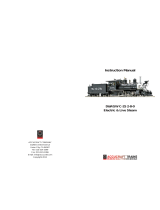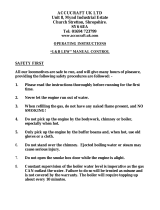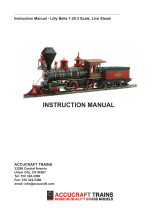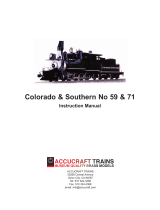Page is loading ...

ACCUCRAFT COMPANY
33268 Central Avenue
Union City, CA 94587
Tel: 510-324-3399
Fax: 510-324-3366
Email: [email protected]
Copyright 2009
INSTRUCTION MANUAL
RUBY #5 LIVE STEAM

RUBY Live Steam Instructions
1
Thank you for purchasing Accucraft Trains
Live Steam Locomotive RUBY.
Like other fi ne models from Accucraft Trains. RUBY has been
designed to provide a lifetime of model railroading pleasure.
RUBY is handcrafted in brass and is a precision piece of equip-
ment. Like all fi ne equipment it must be properly maintained and
cared for.
Notice
The information in this document is subject to change without notice.
RUBY Live Steam Instructions
Please read following directions before unpacking your locomotive.
1. Remove foam around the locomotive. Slide the inner box cover to the side,
and open the inside cardboard box with a cutting knife.
2. Place taped locomotive on a fl at surface. Carefully cut the tape along the
wood board side surface. Be sure to cut both sides of the wood board. Slowly
lift the tape from the locomotive. Be very careful with small parts. Tape cannot
be re-used to re-pack the model. Use new packing tape if necessary.

RUBY Live Steam Instructions
9
Limited One-Year Warranty
Accucraft Trains warrants that the mechanical components of its model trains
will be free of any defect or malfunction under normal use for one year of the
original purchaser and will remedy any mechanical components which prove
to be thus malfunction. This warranty does not extend to : (1.) any damage
to the locomotive resulting from any improper or unreasonable use of the lo-
comotive or from any use of the locomotive in any manner other than that for
which it is intended, (2.) any damage to the fi nish or casting of the locomotive,
or (3.) any other damage (expect for damage resulting from a covered defect
or malfunction) to the locomotive while in the possession of any consumer.
This warranty is given in lieu of all other express warranties. All implied war-
ranties, including but not limited to the implied warranties of merchant ability
and fi tness for a particular purpose shall expire one year from date of original
purchase. (Note: the foregoing limitation on implied warranties is proper un-
der Magnuson-Moss Warranty Act.) UNDER NO CIRCUMSTANCES SHALL
ACCUCRAFT TRAINS BE RESPONSIBLE FOR ANY INCIDENTAL OR
CONSEQUENTIAL DAMAGES ARISING IN REGARD TO ANY ACCUCRAFT
PRODUCT.
In order to validate this warranty, the Owner Registration Card enclosed with
your locomotive must be completed and mailed within ten (10) days after
purchase of the model.
If warranty service is required after more than one year from the date of pur-
chase, please request return authorization by phone or letter. Upon receipt of
authorization, please send the locomotive, postage prepaid, with a check or
money order for the amount of $30.00 in U.S. currency, (price applies to U.S.
only) to cover return postage and handling. Also please write a letter explain-
ing the nature of your problem and enclose it with the locomotive.
RUBY Live Steam Instructions
2
RUBY #5
Features:
Ready to Run
All Brass Construction
Radio Control Ready
Piston-Type Slide Valves
Fixed Eccentric
Piston-Type Reversing Valve
Pressure Gauge

RUBY Live Steam Instructions
3
General Information
RUBY is a freelance, 1:20.3 scale, live-steam locomotive based on Baldwin
practice. It has been designed to be both simple to operate and sophisticated
enough to satisfy more experienced modelers. With proper care, RUBY
should give years of service in the garden.
Operating a live-steam locomotive is much different from running an electri-
cally powered engine. It is a more hands-on, interactive experience. The loco-
motive must be periodically fueled, oiled, and watered. As supplied, RUBY is
manually controlled, which means that you must actually drive the locomotive
using the controls in the cab, just as you would a full-size engine.
The performance of the engine is also unlike electric locomotives. RUBY
should pull two to four standard-size freight cars on good, level track, which is
about the same capacity as a full-size locomotive of this confi guration. Grades
and sharp curves will diminish its capability. A good engineer will learn the
engine’s characteristics and idiosyncrasies over time to get the best perfor-
mance and longest duration from it.
Technical Specifi cations
Scale: 1:20.3 (15mm=1’0”)
Gauge: 45mm
Wheel Arrangement: 0-4-0T
Boiler: Single Flue, Gas Fired, Silver-Soldered Copper,
Tested To 150psi (working pressure, 30psi)
Boiler Fittings: Safety Valve, Throttle, Pressure Gauge
Fuel: Butane gas
Cylinder Lubrication: Displacement Lubricator In The Cab
Cylinder: Fixed Cylinders, Piston-type Valves,
Exhaust Through The Stack
Valve Gear: Fixed Eccentric Via Rocker Arms
Reversing Gear: Piston-Type Reversing Valve Controlled From The
Cab
RUBY Live Steam Instructions
8
Shutting down:
At the end of the day’s run, close the throttle snugly. When cool, the safety
valve should be loosened to relieve the vacuum that will be created in the
boiler. This vacuum could pull oil from the lubricator into the boiler if the
throttle is not closed.
After a day’s operation in the garden you’ll probably fi nd that your engine has
a coating of oil. This is steam-cylinder oil that has been exhausted from the
stack. A simple wipe down with a dry cloth is all that’s necessary to restore
the engine to pristine condition. This is best done while the engine is still hot.
Wipe any grit and excess oil from the wheels and running gear.
The boiler can be drained of water, or not, as you will. Leaving water in the
boiler will not harm it. The lubricator can also be drained and refi lled with
steam oil in preparation for the next run.
Notes on radio control:
Although RUBY was designed as a manually controlled locomotive, there
is no reason why radio control (R/C) cannot be fi tted with some ingenuity. A
two channel radio is all that’s necessary, one for the throttle and one for the
reversing lever. The gas valve should always be controlled manually. Servos
can be mounted to the fl oor of the loco and linked to the control arms. The
reversing lever will have to be modifi ed so that it does not lock in position, but
it must still have stops at either end of its throw for proper positioning of the
reversing valve. You might be able to get away with one servo controlling only
the reversing valve, but better control of the locomotive will be accomplished if
the throttle is controlled, too.

RUBY Live Steam Instructions
7
Running
With the engine on the track, and without a train, open the throttle. Because
the cylinders are cold, the hot steam entering them will condense into wa-
ter and be exhausted out the stack. Hot water squirting out the stack at the
start of a run is normal. RUBY will need to be pushed back and forth until the
cylinders heat up. You may need to exert a little downward pressure on the
engine to get the wheels to turn, which will overcome the resistance of the
water in the cylinders. Be sure to put the engine into reverse, using the lever
at the right side of the cab, when pushing it backwards. When the cylinders
have warmed a little, the engine will begin to show signs of life. After a few
moments, it should take off on its own, moving away smoothly.
Once the engine is running smoothly, a train can be coupled on and the run
can proceed. Since all of RUBY’s functions are controlled from the cab, it can
be driven like a full-size loco, meaning that you’ll have to stay with the engine
throughout the run if you want to change its speed or direction. If you have a
suitable track, the engine can be left to run on its own at a steady speed until
the fuel runs out. As the gas tank in the cab warms, you may fi nd the engine
picking up speed. Simply turn the gas down a little and throttle the steam
back. This is all part of learning how to get the best performance from your
engine.
A word on speed: Little engines like RUBY were rarely run at more than 5 or
10 mph. If you imagine a little person running alongside, that is about the right
prototypical speed. When run at this slower speed, steam and fuel consump-
tion are lower, which increases the run time.
RUBY was designed to run out of fuel before running out of water, thus pre-
venting damage to the boiler. Care should be taken never to run the boiler
dry. When the run is over and the locomotive has cooled somewhat, it can be
lubricated, rewatered, and refueled for the next run.
RUBY Live Steam Instructions
4
Safety
For your safety, there are certain rules that should be observed, as follows:
1. The safety valve has been set at the factory to release at 30 pounds per
square inch of pressure. Never tamper with the safety valve.
2. The fi ring system has been designed to use butane gas only. Never use
any other gas (including propane or butane/propane mix), as the storage
pressures can reach unsafe levels.
3. Always refuel the engine away from other working live-steam locomotives.
The fuel fi lling system allows a small amount of the gas to bleed off as
the fuel tank is being fi lled. A passing engine can ignite this bleed-off gas,
causing a potentially hazardous situation.
4. When lighting up, light the match fi rst, then turn on the gas.
5. A steam engine gets hot. Be careful. Lift the Forney by holding the end
steps when hot.

RUBY Live Steam Instructions
Preparing the engine
A steam-locomotive engineer goes through a lighting-up ritual every time the
engine is to be run. It is good to follow the same routine each time so that
nothing is overlooked.
1. Oil all external moving parts of the engine with a high grade, lightweight
machine oil like 3-in-1.
2. Remove the cab roof. Drain any water from the displacement lubricator in
the cab and fi ll the lubricator to the top with proper steam cylinder oil. This
lubricator makes sure the cylinders and valves are lubricated inside. As the
steam passes through it, a small amount will condense into water. This water
will sink to the bottom of the lubricator, forcing a similar quantity of oil into the
steam line and thus to the cylinders.
3. Fill the boiler (make sure the throttle is closed). A properly fi lled boiler will
have 80ml of water in it. Do not fi ll the boiler full to the top. There must be
room for the steam above the water level. If there is water in the boiler already
and you don’t know how much, fi ll the boiler to the top, then remove 30ml.
Use only distilled water in your engine’s boiler. Tap water contains minerals
that will leach out and ultimately affect the performance of the engine.
4. Finally, add fuel. Butane gas can be purchased at the grocery store or at
a tobacconist’s as cigarette-lighter refi lls. These come with a nipple suitable
for the fi ller valve on the RUBY’s gas tank. Butane can also be purchased
in larger containers at camping-supply stores, but these cans will require a
special adapter for fi lling. Simply press the nozzle of the butane canister hard
onto the fi ller valve. You will hear the gas transferring and see a little gas
bleeding out of the valve. When the tank is full, the gas will begin to splutter
and much more gas will escape the valve. When the gas tank is full and the
cab roof 5has been replaced, you are ready to fi re up the engine.
5
Lubricator
Butane Filler Valve
Filler Plug
Burner
RUBY Live Steam Instructions
6
Firing up
RUBY’s burner resides at the back of the fl ue inside the boiler. Open the
hinged smokebox door at the front of the engine and you’ll be able to see the
fl ue. To light up, strike a match and hold it at the open smokebox door while
simultaneously opening the gas valve in the cab very slowly until the gas
ignites. You should hear the gas coming into the burner. Opening the valve
too wide or too fast may blow out the fl ame or cause the fi re to burn in the
smokebox.
The fi re should fl ash back into the back of the fl ue with a quiet “pop.” If it
wants to burn in the smokebox or in the forward part of the fl ue, slowly close
the gas valve until it fl ashes back to the burner. Don’t let the fi re burn in the
smokebox your engine will not run as it should and maybe damaged. The
fl ame should be bright blue and should burn steadily. The object is to run the
burner at the lowest setting possible to operate the engine, thereby increasing
the effi ciency of the engine and the duration of the run. You’ll get the hang of
this with practice
When the safety valve blows, you’ll know that pressure is up to working level.
This should take 5-8 minutes or so. The air temperature will have an effect on
this. It will take longer on cold days and less on hot days. Butane gas turns to
non-pressurized liquid at 32°F, so the engine may have diffi culty on very cold
days, unless it is fi red up indoors.
/

















